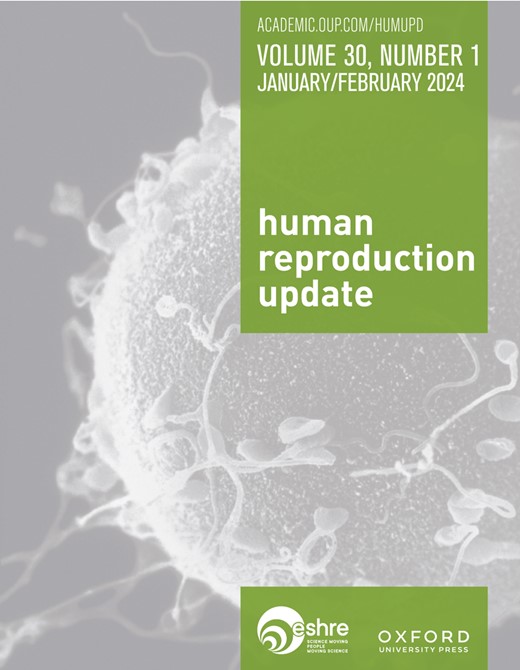Infertility treatment and offspring blood pressure-a systematic review and meta-analysis.
IF 16.1
1区 医学
Q1 OBSTETRICS & GYNECOLOGY
引用次数: 0
Abstract
BACKGROUND Studies have inconsistently observed that children conceived by IVF or ICSI have higher blood pressure compared to children not conceived by these ARTs. OBJECTIVE AND RATIONALE The aim was to perform a systematic review and meta-analysis of blood pressure measures of offspring conceived by ART and those conceived naturally. Resolving the suspicion of ART as a risk factor of higher blood pressure, and therefore of heart disease, has public health and clinical implications. SEARCH METHODS A biomedical librarian searched the Embase, PubMed, and Web of Science databases. Searches were limited to records published in English since 1978. Grey literature was searched. Inclusion criteria were humans born via infertility treatment (vs no treatment) who underwent a blood pressure assessment. Exclusion criteria were non-human participants, non-quantitative studies, absence of a control group, and specialty populations (e.g. cancer patients only). Two reviewers independently screened each record's title and abstract and full text using Covidence, extracted data using Excel, and assessed bias using the National Heart, Lung, and Blood Institute's Quality Assessment Tool for cohort studies. OUTCOMES Of 5082 records identified, 79 were included in the systematic review and 36 were included in the meta-analysis of systolic blood pressure (SBP) and diastolic blood pressure (DBP) in ART and non-ART groups. Overall, 34 reports including 40 effect sizes from 25 unique cohorts, compared blood pressure between ART (N = 5229) and non-ART (N = 8509, reference) groups with no covariate adjustment. No standardized mean differences (SMD) in SBP (0.06 per SD of mmHg, 95% CI = -0.05, 0.18) or DBP (0.11, 95% CI = -0.04, 0.25) by treatment were found, but the heterogeneity was considerable (I2=76% for SBP and 87% for DBP). Adjusted analyses were presented in 12 reports, representing 28 effect sizes from 21 unique cohorts (N = 2242 treatment vs N = 37 590 non-treatment). Studies adjusted for varied covariates including maternal (e.g. age, education, body mass index, smoking, pregnancy complications), child (e.g. sex, age, physical activity, BMI, height), and birth characteristics (e.g. birth weight and gestational age). Adjusted results similarly showed no SMD for SBP (-0.03, 95% CI = -0.13, 0.08) or DBP (0.02, 95% CI = -0.12, 0.16), though heterogeneity remained high (I2 = 64% and 86%). Funnel plots indicated a slight publication bias, but the trim and fill approach suggested no missing studies. Removal of five studies which adjusted for birth outcomes (potentially over-adjusting for mediators) made no material difference. Type of treatment (e.g. IVF vs ICSI), period effects by birth year (≤2000 vs >2000), offspring age group (<8, 8-14, 15+), or study location (e.g. Europe) did not modify the results. WIDER IMPLICATIONS In conclusion, conception by ART was not associated with offspring blood pressure in a meta-analysis, although considerable heterogeneity was observed. Given the increasing number of children born using ART, perpetuating a difference in blood pressure would mean unnecessary risk screening for many children/adults on a population level. At a clinical level, couples considering these reproductive technologies have some reassurance that there is no evidence of strong vascular 'programming' due to the techniques used. REGISTRATION NUMBER PROSPERO No. CRD42022374232.不孕症治疗与后代血压--系统回顾与荟萃分析。
背景研究发现,通过试管婴儿或卵胞浆内单精子显微注射(ICSI)受孕的儿童与非通过这些人工授精技术受孕的儿童相比,血压较高,这一点并不一致。解决关于 ART 是导致血压升高并进而导致心脏病的风险因素的怀疑具有公共卫生和临床意义。检索方法SA 生物医学图书管理员检索了 Embase、PubMed 和 Web of Science 数据库。搜索仅限于 1978 年以来发表的英文文献。还检索了灰色文献。纳入标准为通过不孕症治疗(与未接受治疗)出生并接受血压评估的人类。排除标准为非人类参与者、非定量研究、无对照组和特殊人群(如仅癌症患者)。两名审稿人使用 Covidence 独立筛选每条记录的标题、摘要和全文,使用 Excel 提取数据,并使用美国国家心肺血液研究所的队列研究质量评估工具评估偏倚。总体而言,34 份报告(包括来自 25 个独特队列的 40 个效应大小)比较了抗逆转录病毒疗法组(N = 5229)和非抗逆转录病毒疗法组(N = 8509,参考组)之间的血压,未进行协变量调整。没有发现治疗方法对 SBP(每 SD mmHg 0.06,95% CI = -0.05,0.18)或 DBP(0.11,95% CI = -0.04,0.25)的标准化均值差异 (SMD),但异质性相当大(SBP 的 I2=76%,DBP 的 I2=87%)。调整后的分析结果载于 12 份报告中,代表了来自 21 个独特队列的 28 个效应大小(N = 2242 治疗 vs N = 37 590 非治疗)。研究对各种协变量进行了调整,包括母亲(如年龄、教育程度、体重指数、吸烟、妊娠并发症)、儿童(如性别、年龄、体力活动、体重指数、身高)和出生特征(如出生体重和胎龄)。调整后的结果同样显示,SBP(-0.03,95% CI = -0.13,0.08)或 DBP(0.02,95% CI = -0.12,0.16)没有 SMD,但异质性仍然很高(I2 = 64% 和 86%)。漏斗图显示有轻微的发表偏倚,但修剪和填充法表明没有遗漏的研究。删除了五项对出生结果进行调整的研究(可能对中介因素进行了过度调整),但这些研究并无实质性差异。治疗类型(如体外受精与卵胞浆内单精子显微注射)、出生年份的时期效应(≤2000 vs >2000)、后代年龄组(<8、8-14、15+)或研究地点(如欧洲)均未改变结果。鉴于通过抗逆转录病毒疗法出生的孩子越来越多,血压差异的长期存在将意味着在人口层面对许多儿童/成人进行不必要的风险筛查。在临床层面上,考虑使用这些生殖技术的夫妇可以放心,没有证据表明使用这些技术会导致血管 "程序化"。
本文章由计算机程序翻译,如有差异,请以英文原文为准。
求助全文
约1分钟内获得全文
求助全文
来源期刊

Human Reproduction Update
医学-妇产科学
CiteScore
28.80
自引率
1.50%
发文量
38
期刊介绍:
Human Reproduction Update is the leading journal in its field, boasting a Journal Impact FactorTM of 13.3 and ranked first in Obstetrics & Gynecology and Reproductive Biology (Source: Journal Citation ReportsTM from Clarivate, 2023). It specializes in publishing comprehensive and systematic review articles covering various aspects of human reproductive physiology and medicine.
The journal prioritizes basic, transitional, and clinical topics related to reproduction, encompassing areas such as andrology, embryology, infertility, gynaecology, pregnancy, reproductive endocrinology, reproductive epidemiology, reproductive genetics, reproductive immunology, and reproductive oncology. Human Reproduction Update is published on behalf of the European Society of Human Reproduction and Embryology (ESHRE), maintaining the highest scientific and editorial standards.
 求助内容:
求助内容: 应助结果提醒方式:
应助结果提醒方式:


